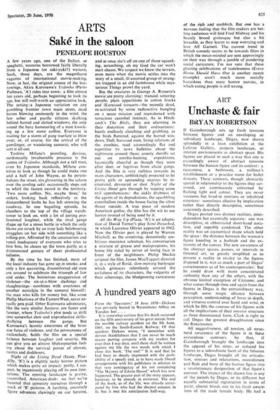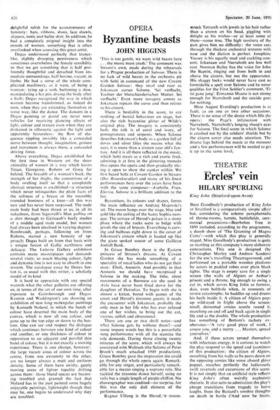ART
Unchaste & fair
BRYAN ROBERTSON
If Gainsborough sets up fresh tensions between figures and an enveloping or subsidiary landscape, Degas, now shown splendidly in a loan exhibition at the Lefevre Gallery, projects landscape, or
interior environments as abstract space. His figures are placed in such a way that one is exceedingly aware of abstract tensions between the human figure and its context : a racecourse, a bathroom, a milliner's establishment or a practice room for ballet dancers. These contexts, though abstractly spatial in relationship to the figures they sur- round, are continuously enlivened by flashing light and colour. They are never vacuums but lived-in interiors or inhabited exteriors: sometimes allusive by implication rather than directly descriptive, sometimes concretely described.
Degas posited two distinct realities, inter- dependent but essentially separate: one was descriptive, in abbreviated short-hand nota- tion, and superbly condensed. The other reality was an asymetrical shape which held the space: the distance between the woman's figure kneeling in a bathtub and the ex- tremity of the canvas. The new awareness of the abstract spaces, pauses, or intervals in Oriental art, so greatly simplified as to present a reality in rivalry to the figures disposed in it, was as much a part of Degas' consciousness as of his contemporaries'. But he could draw with more concentrated authority than any of the others, with the obvious limited exception of Cezanne; and what comes through time and again from the figures in Degas is the extraordinary way, through some magic alliance between perception, understanding of form in depth, and virtuoso control over hand and wrist, in
which he fills the contour of his figures with all the implications of their interior structure
as three dimensional form. Clark is right to call Degas the greatest draughtsman since the Renaissance.
All suggestiveness, all tension, all struc- tural awareness of the figure is in these miraculous contours. So that, if Gainsborough brought the landscape into the apparel of his sitter, or reduced his figures to a subordinate facet of the fulsome landscape, Degas brought all the articula- tion, stresses and relaxations, musculature and flesh and bone of the human figure into a revolutionary designation of that figure's contour. The impact of the drawn line in any of the pastels by Degas, or its different but equally substantial registration in terms of paint, almost blinds one to his fresh aware- ness of the nude female body. He had a delightful relish for the accoutrements of feminity: hats, ribbons, shoes, lace shawls, slippers, tunic and ballet skirt. In addition, he had a completely original insight into the moods of women, something that is often overlooked when assessing this great artist.
Degas understood perfectly that trance- like, slightly drooping pensiveness which sometimes overwhelms the female sensibility so that we get something that is half pro- foundly thoughtful and detached from im- mediate surroundings, half bovine, vacant, in limbo. He had a sense of the whole com- plicated machinery, as it were, of being a woman: tying up a sash, buttoning a shoe, manipulating a hat pin, drying the body after a bath; Degas recognised the way in which women become transformed, as indeed do men, when they are extending themselves in some way, like the dance. The dancers in a Degas painting or pastel are never mere vehicles for receiving glancing effects of light, colour and texture even when they are darkened in silhouette against the light and apparently featureless: the flow of elo- quence rippling invisibly like a concealed nerve between thought, imagination, gesture and movement is always there, a concealed driving force.
Above everything, Degas established for the first time in Western art the sheer animality of women in a way which leaves Titian, Giorgione, Rubens or Goya far behind. The breadth of a woman's back, the strength of her thighs, the contortions of a body swelling itself so that a completely abstract structure is established—a structure which never relinquishes the plain facts of the softness of a breast or the smoothly rounded boniness of a knee—all this was new and has never been surpassed. The nude male body had been thrust at us, in all its nakedness, from Signorelli's Man pulling on a shirt through to Gericaules beefy studies of a middle aged male model, but women had always been idealised in varying degrees. Rembrandt, perhaps, following on from Rubens, started a new honesty of ap- proach; Degas built on from that basis with a unique fusion of Gallic earthiness and delicacy. The Lefevre Gallery exhibition contains many masterpieces and demands several visits; so much blazing colour, light and dynamic line is not easy to absorb in one session. The catalogue essay by Denys Sut- ton is, as usual with this writer, a scholarly model of its kind.
It is hard to appreciate with any special warmth what the other galleries are offering us, in terms of the art of our own time, after exposure to Gainsborough and Degas. Kasmin and Waddington's are showing an exhibition of new long rectangular paintings by Kenneth Noland, in which the bands of colour have deserted the main body of the canvas, which is now all one colour, and gone up to the top edge or down to the bot- tom. One can see and respect the dialogue which continues between one kind of colour and another, or one thickness of colour in opposition to an adjacent and parallel thin band of colour, but it is not exactly a moving experience. There is one change, however: the large vacant areas of colour across the centre, from one extremity to the other, are no longer always a matt and uniform density. Some of them have swishy, gently moving areas of lighter twtality drifting across them: those bland spaces are becom- ing troubled and, granted the fact that Noland has in the past painted some hugely enjoyable paintings, lightweight though they may be, one begins to understand why they are troubled.



































 Previous page
Previous page